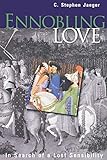Ennobling Love : In Search of a Lost Sensibility / C. Stephen Jaeger.
Material type: TextSeries: The Middle Ages SeriesPublisher: Philadelphia : University of Pennsylvania Press, [2010]Copyright date: ©1999Description: 1 online resource (328 p.)Content type:
TextSeries: The Middle Ages SeriesPublisher: Philadelphia : University of Pennsylvania Press, [2010]Copyright date: ©1999Description: 1 online resource (328 p.)Content type: - 9780812216912
- 9780812200621
- 809 21
- PN682.L68 J34 1999eb
- online - DeGruyter
- Issued also in print.
| Item type | Current library | Call number | URL | Status | Notes | Barcode | |
|---|---|---|---|---|---|---|---|
 eBook
eBook
|
Biblioteca "Angelicum" Pont. Univ. S.Tommaso d'Aquino Nuvola online | online - DeGruyter (Browse shelf(Opens below)) | Online access | Not for loan (Accesso limitato) | Accesso per gli utenti autorizzati / Access for authorized users | (dgr)9780812200621 |
Frontmatter -- Contents -- Preface -- Introduction: Cordelia on Trial -- 1. Problems of Reading the Language of Passionate Friendship -- 2. Virtue and Ennobling Love ( i ) : Antiquity and Early Christianity -- 3. Love of King and Court -- 4. Love, Friendship, and Virtue in Pre-Courtly Literature -- 5. Love in Education, Education in Love -- 6. Women -- 7. Sublime Love -- 8. Love Beyond the Body -- 9. Sleeping and Eating Together -- 10. Eros Denied, Eros Defied -- 11. Virtue and Ennobling Love (2): Value, Worth, Reputation -- 12. The Epistolae duorum amantium, Heloise, and Her Orbit -- 13. The Loves of Christina of Markyate -- 14. Virtuous Chastity, Virtuous Passion - Romantic Solutions in Two Courtly Epics -- 15. The Grand Amatory Mode of die Noble Life -- Appendix: English Translations of Selected Texts -- Notes -- Bibliography -- Index
restricted access online access with authorization star
http://purl.org/coar/access_right/c_16ec
"Richard, Duke of Aquitaine, son of the King of England, remained with Philip, the King of France, who so honored him for so long that they ate every day at the same table and from the same dish, and at night their beds did not separate them. And the King of France loved him as his own soul; and they loved each other so much that the King of England was absolutely astonished at the vehement love between them and marveled at what it could mean."Public avowals of love between men were common from antiquity through the Middle Ages. What do these expressions leave to interpretation? An extraordinary amount, as Stephen Jaeger demonstrates.Unlike current efforts to read medieval culture through modern mores, Stephen Jaeger contends that love and sex in the Middle Ages relate to each other very differently than in the postmedieval period. Love was not only a mode of feeling and desiring, or an exclusively private sentiment, but a way of behaving and a social ideal. It was a form of aristocratic self-representation, its social function to show forth virtue in lovers, to raise their inner worth, to increase their honor and enhance their reputation. To judge from the number of royal love relationships documented, it seems normal, rather than exceptional, that a king loved his favorites, and the courtiers and advisors, clerical and lay, loved their superiors and each other.Jaeger makes an elaborate, accessible, and certain to be controversial, case for the centrality of friendship and love as aristocratic lay, clerical, and monastic ideals. Ennobling Love is a magisterial work, a book that charts the social constructions of passion and sexuality in our own times, no less than in the Middle Ages.
Issued also in print.
Mode of access: Internet via World Wide Web.
In English.
Description based on online resource; title from PDF title page (publisher's Web site, viewed 23. Jul 2020)


